Are you struggling to find the best ways to attract new customers to your small business? Most probably that’s the reason you’re here. And yeah! Lead generation can be the solution for you.
What Is A Lead and Lead Generation?
How can I attract visitors and compel them to contact my business? The key is providing what your potential customer may be looking for: useful content that answers your audience’s questions, a user-friendly website with a lovely design, and clear call to actions.
Now, lead generation is all the strategies we implement to attract strangers, convert them into leads, and later into loyal customers.
Think of it as planting a tree.
First, you prepare the soil (your website and its content). Then, you choose the right seeds, and your target audience is the seed in this journey. You need to water your seeds consistently (through SEO, ads, social media, and email campaigns). Not every seed will grow into a plant, though. In other words, not every lead will turn into a customer. But with care and patience, the right ones will bloom into loyal buyers.
We can classify leads into three groups: hot, warm, and cold leads. This grouping is based on the leads’ readiness to make a purchase. Hot leads are actively looking to purchase; warm leads are slightly interested in what you offer, and cold leads have shown no engagement at all.
Inbound vs. Outbound Lead Generation
You have more than one way to generate leads, and all these ways typically fall into two categories:
-
Inbound Lead Generation: In this way, the leads come to you because you attracted them in some way.
-
Outbound Lead Generation: In this way, you approach potential buyers directly, similar to pitching your product in person, only it happens on your mobile device this time.
Why Do I Need Lead Generation?
Lead generation is vital for small businesses as it directly impacts your ability to grow. With over 8.5 billion searches performed each day, Google represents a massive opportunity for businesses to reach potential customers. By effectively generating leads, small businesses can:
-
Increase Sales and Revenue: Attracting and converting more leads boosts sales and revenue.
-
Build Brand Awareness: Consistent lead generation efforts increase brand visibility and awareness among potential customers.
-
Enhance Customer Relationships and Loyalty: Engaging with leads through personalized marketing strategies builds stronger customer relationships and loyalty.
-
Optimize Marketing Efforts: Understanding which lead generation techniques work best allows businesses to optimize their marketing strategies and allocate resources more efficiently.
-
Gain Competitive Advantage: Staying ahead with innovative lead generation strategies gives small businesses a competitive edge in the market.
Best Lead Generation Strategies in 2025
If you've ever tried different lead generation strategies, you likely understand how broad the concept is. You search for “lead generation” on Google, and there are thousands of articles, plenty of blog posts, and numerous videos. You watch and read, but still, the whole thing is foggy and difficult to comprehend. Well, we’re here to break the entire concept down into bite-sized pieces.
-
Cold Outbound Lead Generation:
In this type of lead generation, you reach out to people who may be your potential customers. This is done by cold calling, cold emailing, leaving LinkedIn messages or Instagram DMs, leaving voicemail drops, or sending text messages.
Email Marketing
Building an email list and nurturing leads with personalized content is effective for lead generation. This way, you can convert subscribers into loyal customers through targeted email campaigns. For instance, you can offer a free eBook in exchange for leads' email addresses to build your email list. Then, you can send personalized tips and exclusive discounts to convert subscribers into loyal customers through targeted email campaigns. Here’s what you should do for email marketing:
-
Building an Email List: Building an email list grows your subscriber base through lead magnets, pop-ups, and website forms.
-
Crafting Compelling Email Campaigns: The next step is creating email content that educates, inspires, and drives conversions. You can specify your audience for personalized messaging and track the performance to optimize results.
Social Media Marketing
In today's modern and technological world, being active on social media is no longer an option; it's a necessity. Effective social media marketing allows you to connect with your target audience, build brand awareness, and drive conversions.
At Top Organic Leads, we don’t offer social media marketing, but it’s still an effective strategy for your business.
-
Facebook, Instagram, and TikTok: You can use these platforms to engage potential customers and showcase your business. They’re especially useful if you’re a B2C business and your customers are people who use Instagram and Facebook everyday.
-
LinkedIn: LinkedIn allows you to engage potential customers and showcase your business. It’s especially needed for B2B businesses, because your audience is CEOs who are actively present on LinkedIn.
Having a strong presence on social media platforms allows you to establish your brand's voice, create valuable content, and foster a loyal community. This loyal community is built through interactive posts and responding to comments, which are different ways of engaging with your audience. You can also benefit from targeted social media ads. This way, you reach your ideal customers, one actively looking for your product or service. Using platforms like Instagram and TikTok enables the use of demographic, interest, and behavior targeting options.
Referral Marketing
What makes people trust you more than just your own words? YES, it’s people’s words. The power of word-of-mouth is something people usually neglect in business, but it's really beneficial. You can reward loyal customers for referring you to friends and family. Turn satisfied clients into brand advocates through a referral program.
Networking Events
Networking events in your industry provide opportunities to meet potential customers and build lasting relationships. By attending or hosting events, you can connect with industry peers, share insights, and explore collaboration opportunities. These events provide a platform for networking and partnerships.
-
Lead Generation Opportunities: This strategy can enhance your inbound lead generation efforts and integrate well with social media lead generation tactics. This is crucial for B2B lead generation (business-to-business lead generation, which involves identifying and attracting potential business clients) and local lead generation.
-
Collaborating with Other Businesses: Attending industry events enables you to connect with like-minded professionals, stay updated on industry trends, and partner with complementary businesses. It helps you reach a wider audience and increase your market share.
-
Paid Advertising:
It goes without saying that this type of lead generation is implemented by advertising on different platforms, such as **Meta ads** (Facebook or Instagram) or **search ads** (Google, Microsoft, and YouTube). The important point to consider is to get educated before running an advertisement campaign, since you might do it wrong and waste your advertising budget.
Read more about Paid Ads [here](https://www.toporganicleads.com/lead-generation-/what-is-lead-generation/paid-ads-ppc/).
-
Long-Lasting Lead Generation:
Opposing paid ads that bring leads immediately, these solutions take a long time to result, at least three months. However, once they bring leads for you, the result will be everlasting unless a competitor employs better strategies. This type of lead generation has the lowest cost and the best result in terms of lead quality.
SEO: Search Engine Optimization or SEO for short, is optimizing your website to better align with Google algorithms and provide the best performance for users. The results show up in the long term, depending on how competitive your search phrases are. The downside of this kind of lead generation is that you need to work with an expert to get the best results, and there are a lot of fake experts in this field, so finding someone that you can trust is absolutely challenging.
Organic Social: Creating YouTube videos or building an audience on TikTok or Instagram is a way of promoting yourself as an organic social strategy. These videos might not lead to immediate audience and income, but they’re an investment for the long term, especially YouTube videos that will stay online for a long time and get viewers even years after posting.
-
Utilizing Customer Reviews and Testimonials: Actively seek feedback from your customers to identify areas for improvement and transform it into powerful marketing tools. These genuine reviews can build trust and credibility.
-
Showcasing Testimonials on Your Website: Highlight positive customer experiences to influence potential customers and boost conversions.
-
Partner Up with Us to Generate New Leads!
Call now to consult with our digital marketing experts.
Lead Generation Steps
There are six major phases in the lead generation process. One must follow all the steps to convert a lead into a loyal customer. Top Organic Leads help you with this process.
-
Attract:
In the initial phase, you try to attract strangers to your website on Google. We accomplish that by using engaging content that includes all the keywords, offering incentives such as free trials and discounts, and of course website optimization.
There's a fair amount of details that need to be considered when designing your website so that your efforts turn out and earn actual leads. Here is a brief list of what we take into account for a well-performing website:
- UX/UI design
- Mobile-Friendly Website (responsive)
- Fast Loading Site
- Engaging content
- Using keywords
- Social media posts
- Paid ads on Google, LinkedIn, and Facebook
- Videos
- Social Proof (Google reviews, Facebook follows, etc.)
We help you with many of the options mentioned; we redesign your website with useful content and gorgeous design. We also strive to enhance the quality of your website by speed optimization and mobile friendliness.
-
Capture:
The number of customers you have is, without question, less than the number of generated leads. Similarly, the total number of leads isn’t necessarily equal to the traffic your website receives.
Your traffic shows how many people visited your website, how long they stayed, and which pages they viewed. These visitors become leads when they leave any of their contact information for you or give you a call.
But what triggers them to contact you?
Many believe that they must offer something in exchange, such as free consultation or downloadable booklets. These offers are called lead magnets, and using them is thought to gather prospects' contact info. But we don't approve of this particular point of view. The trust in the business and the CTA is what encourages the buyer to contact you. Not the freebies. That's for cheesy sites, not professionals.
That means this stage is for you to turn visitors into leads.
-
Qualify
This is the stage where we evaluate the leads’ potential to see if they’re ready to make a purchase. Qualifying leads and categorizing them into the mentioned groups require specific tools. The examples are:
-
Employing lead forms that contain qualifying questions, such as those regarding budget, company size, and industry. This is one way, but again, it’s something we don’t encourage. Since the leads will drop off before we engage with them, we may turn some leads away because they don't want to share their info. The most successful lead forms are the simplest ones.
-
Tracking users’ behavior, such as the pages they visited or the content they consumed. This empowers us with feasible information about the quality of leads.
-
Lead scoring systems assign points to users based on their engagement. These systems are proposed as a lead qualification tool. For instance, if some users have downloaded a free guide, it's advised to distinguish them from other users who scrolled down and didn’t pay any attention to the guide.
However, we suggest you hold off on the qualification process until the customer contacts the office. Generally, most leads are qualified unless the opposite is proven. The prospects are not qualified if, first, your product or service doesn't meet their expectations, and second, if they can’t afford what you offer. We assume these conditions are true unless it proves to be the opposite.
Over all, lead qualification is an important process that is left to the customers to take care of.
By identifying qualified leads, you spot your potential customers, and then you can invest in them.
-
-
Nurture
At this stage, you build a comprehensive relationship with your highly qualified leads. It means you warm up the leads over time with helpful content. Your sales team is accountable for this stage. Here’s a list of things you can do to nurture your potential customers:
-
Automated email sequences: Not every lead is prepared to make a purchase. Many are highly doubtful about what they should do. With email sequences, you nurture your potential customers and feed them with useful data. This data will help them decide whether or not to buy your product/service. Sequence emails are prewritten and are sent automatically to your leads once they submit their email. A well-known example is the “Here’s How to Get Started” emails.
Data shows that nurture emails generate 4 to 10 times higher response rates than one-off email blasts. Leads nurtured via sequences tend to make 47% larger purchases, convert faster (23–33% shorter sales cycle), and cost 33–45% less per lead.
It’s noteworthy that nurturing isn’t through email only, there are other platforms that can be used to nurture leads, such as text messages, Meta ads, Whatsapp automation, and Linkedin retargeting.
-
Behavior-Based Personalization: People only read content they care about. You can’t send prewritten emails to all your customers and expect them to embrace them openly. You need to optimize your nurturing content to meet the needs of your leads. For example, if your lead has looked for pricing, you must nurture them with content about ROI, since that is what they care about. Or if they abandoned a cart, send them reminders or discounts.
-
We’ve already mentioned lead scoring. When scoring leads based on their activity, you can prioritize some over others and spend more time and energy on nurturing those individuals. Low-scored leads only receive educational content, while high-scored leads receive content that draws them towards a sale.
-
Videos are an excellent source for nurturing leads. You can include videos in your emails, and data shows it increases the click rate up to 300%. It’s easier for people to watch a high-quality video than to read a lengthy essay about your product/service.
-
Your nurturing content isn’t supposed to only be an attempt to persuade a purchase. You can educate your audience with helpful information. People trust B2B businesses that offer insight.
-
-
Convert
Now that you’ve educated your potential customers and built trust, you should motivate them to take action and make a purchase. Once you do it, congratulations! You have a paying customer. This stage is where the leads are turned into real customers. Again, your sales team directs this process by encouraging the customer to take the next step: making a purchase or signing a contract. Some strategies motivate your prospects to take action:
-
Sales calls and Meetings: These One-on-one sessions are there to answer your potential customers’ doubts
-
Limited time offers: By proposing limited discounts, you can tempt potential customers to actually make a purchase.
-
Personalised proposals: These proposals advertise what your customers need, not what you sell.
-
Free consultations: At the right time; like when they click a link, watch a video, or view a content
-
Case Studies: Show how successful you’ve been in your journey
-
-
Analyze & Optimize
This is where we come in again. All the steps people have taken before making a purchase are helpful data in tracking and converting new leads. So we make sure we analyze your site’s conversion data as well as your closing rate to better understand where we can improve our system.
Here’s a list of tools you can employ to analyze your data:
- Google Analytics
- Search Console
- Top Organic Leads’ Analysis System
- Marketing Attribution Software
- Smartlook
- HubSpot
Using these systems, we analyze leads’ origins (where each lead is coming from) and their behavior on the website, and what triggers users to take action or leave the website. We assess the value of leads and the customer lifetime value. This way, we understand return on investment (ROI) for each campaign and marketing tool employed (including our own lead generation).
How Do We Generate Leads?
Lead generation occurs through multiple channels: paid ads, SEO, social media marketing as well as email marketing. It's worth noting that AI-assisted lead generation is expanding and now accounts for a big part of lead generation efforts. At Top Organic Leads, we implement the following effective strategies to ensure your business's visibility and engagement.
Here are the top lead generation techniques we use to generate more leads for your business:
Setting up Google Business Profile (GBP)
Providing detailed information on your Google business profile (GBP, formerly known as GMB) is a crucial step in increasing your visibility on the Internet, particularly for local searches. Enhanced visibility results in lead generation. GBP is vital for local businesses as it helps you appear in local search results, provides essential information, and allows you to engage with your customers through reviews. Here are the steps to set up your GBP:
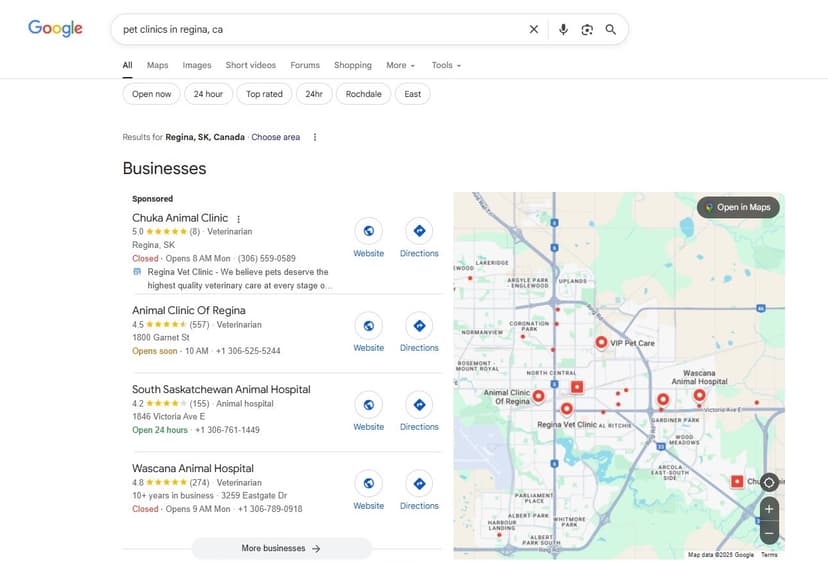
-
Enter A Physical Address: Google My Business requires a physical location for verification purposes. Even if you have an online business, you must provide an address so that Google can send you a verification postcard.
-
Create A Gmail Account: If you don’t have a Gmail account specific for your business, create one. This account will be used to manage your GBP listing.
-
Access Google My Business: Go to the Google My Business page and sign in using your Gmail account.
-
Enter Details to Your Business: Fill out your business name, address, business category, and contact details accurately. The information you provide here will appear in Google’s search results, so it must be up-to-date and correct.
-
Verify Your Business: Google will ask you to verify your business, usually by sending a postcard to your physical address. This process can take up to two weeks. Once verified, your business will start appearing in local searches.
What are the most important things when setting up GBP?
Here are the core elements needed to Optimize your GMB Listing. All the examples are for a client of ours, Newport Hair Loss Center (to see the website: click here).
- Accurate Information: Keep your business information (address, phone number, hours of operation) accurate and up-to-date.
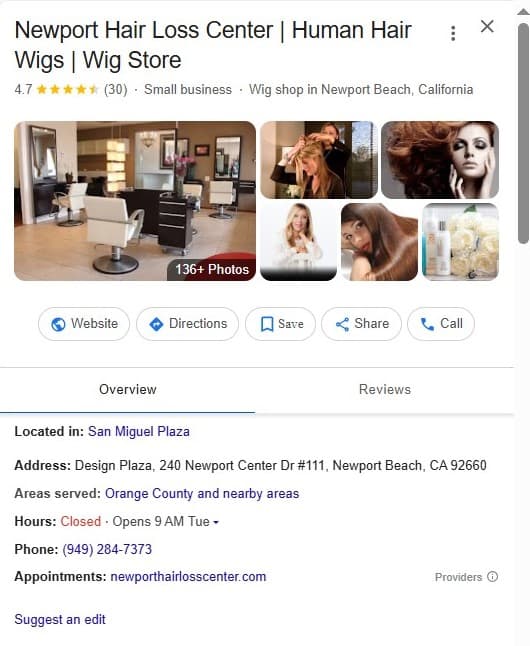
- Business Description: Write a compelling business description about your services and include relevant keywords. This improves your chances of appearing in relevant searches.
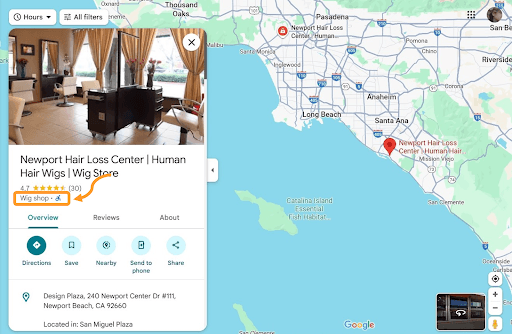
- Photos and Videos: Upload high-quality photos and videos of your business. Visual content makes your listing more engaging and attracts potential customers.
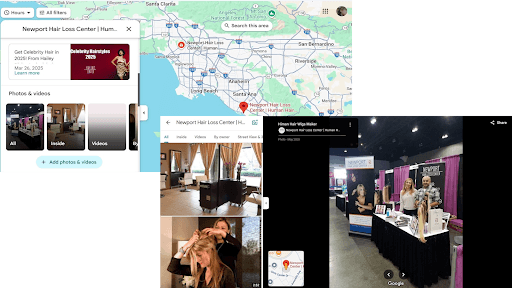
- Google Posts: Use Google Posts to share updates, offers, events, or new products directly on your GBP profile. This feature can keep your audience informed and encourage more interaction.
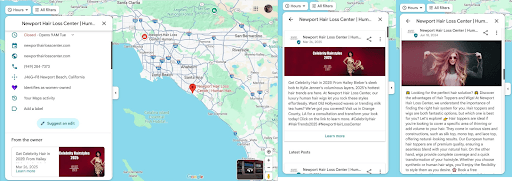
- GBP Reviews: Customers’ reviews are an essential part of GBP. Positive reviews encourage prospects to make a purchase and also result in higher ranks in Google’s search results. There are a couple of things you can do to encourage your customers to leave a review for you, such as offering incentives and discounts, providing direct links to GBP, and responding to reviews.
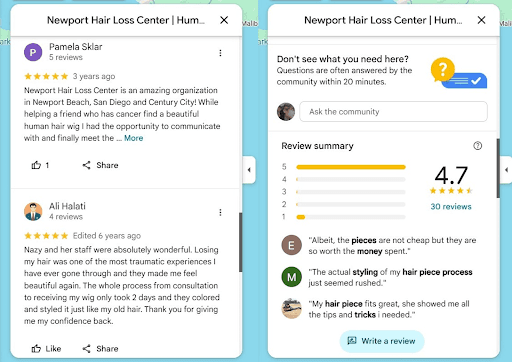
Read this article to learn learn more about setting up and optimizing your Gooble Business Profile page?
Website Optimization
The second most important action we take to generate leads for your [local business] (https://www.toporganicleads.com/local-businesses/) is optimizing your website. A well-performing website captures traffic from Google. It’s needed to attract and convert potential customers. This is how we do it:
Custom Design
Many businesses use template-based websites. These websites are easy to set up and cost-effective. However, they lack the uniqueness needed for high ranking in search results. Hard-coded websites, as opposed to a CMS like WordPress or Wix, are typically faster, more secure, and offer greater flexibility. But why do people still choose template-based websites? Well, hard-coded websites need a skilled developer to manage and update the site.
Our UI/UX designers make every effort to develop the best design for your website. It's worth investing in a hard-coded website because it provides a more personalized experience and is user-friendly. It also enables you to integrate better with SEO practices and meet your specific needs.
Clear and Compelling Headline:
Persuasive and strong headlines grab visitors' attention. So, we strive to clearly state the page's purpose and value proposition in its headline.
High-Quality and Persuasive Content:
Why is everyone speaking of content? Well, it’s the heart of your website. It attracts, engages, and converts prospects. Google prioritizes sites that provide valuable, informative, and engaging content.
Your website can always benefit from clear and concise language, since it’s the best advertisement for your product or service. That’s why we strive to create valuable content such as blog posts to captivate your target audience. We share expert insights, answer FAQs, and position your business as a trusted resource.
The key elements in generating high-quality content are:
-
Integrating keywords
-
Professional copywriting
-
Long-form content
-
Regular blogging
Keyword Analysis:
Your potential customers are out there, searching on Google and looking for a service/product provider like you. How do they find you? What do they search for?
Knowing the keywords in your industry and using them in your content is what we do to ensure the customers will find you. The better keyword optimization you use, the higher your chances of ranking on Google.
To conduct keyword research, we use the following tools:
Strong Visuals:
Many assume that visual content is just a supplement to text. The truth is images and videos are a crucial part of your overall content strategy. Unique, high-quality visuals can improve user engagement and increase time spent on your site. This will enhance your SEO efforts.
Here’s what you need to remember when generating photos for your website:
-
Using original images
-
Using videos showcasing your services or products
-
Optimizing all images and videos

Clear Call-to-Action Buttons (CTAs):
A call-to-action (CTA) is a prompt that encourages visitors to take a specific action.

To create effective CTAs:
-
We use clear and action-oriented language. That means we tell visitors exactly what to do, for example, "Start Your Free Trial," "Download Now".
-
These CTA buttons need to be placed prominently. We generally position them above the fold if possible.
-
We implement strong visual design to attract visitors to the CTA. We make your CTA button visually appealing, so that it stands out from the surrounding content.
-
We also conduct A/B testing and experiment with different CTA variations to determine which performs best.
-
And last but not least, we also create a sense of urgency. We incorporate elements such as limited-time offers or scarcity. These elements encourage immediate action.
Partner Up with Us to Generate New Leads!
Call now to consult with our digital marketing experts.
Fast Loading Speed:
Low-speed websites are such a killjoy. 40% of users leave a website if it takes more than 3 seconds to load. Proven data shows that every 1-second delay in page load time can reduce conversions up to 7%. So, a slow website leads to higher bounce rates and lowers your rankings in Google search results.
We optimize your landing page for fast load times. To accomplish that, we optimize photos, minimize HTTP requests, enable browser caching, and use a content delivery network.
Here’s the test speed for one of our clients’ websites, Aps-hoods. (to see the website see here)
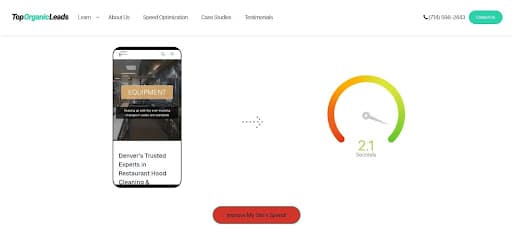
Check your site’s speed with Top Organic Leads. No worries, it’s a short and free test!
Responsive Design and Mobile Optimization:
You don’t know if your visitors are using a phone or a computer, right? That's why you must be prepared for both cases, so a broader audience has access to your website. Furthermore, Google uses mobile-first indexing, meaning it primarily uses the mobile version of your website for ranking. It prioritizes responsive sites because they provide a better user experience across different devices, including desktops, tablets, and smartphones.
We ensure your landing page is responsive and displays correctly on different devices.
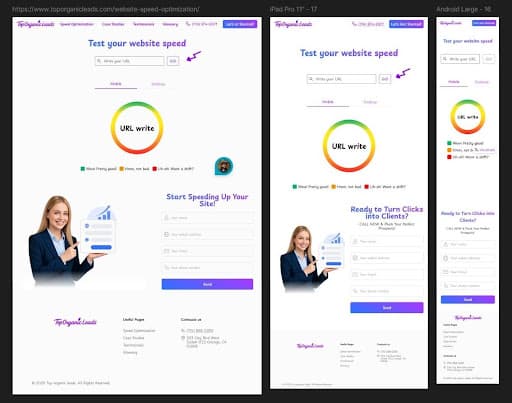
Want to know more about our mobile friendly designs? Check out this.
User-Friendly Navigation
Good website navigation is essential for both user experience and SEO. Visitors should be able to find the information they need quickly and easily, without getting lost in a maze of links.
To navigate your website, we implement:
- Simple menu structure
- Internal linking
- breadcrumbs
On-Page SEO
Imagine you’re opening your own shop downtown. You set up a store window; arrange the signs, products, and lighting so everyone who passes by instantly knows what you offer and is tempted to come in. That’s just like on-page SEO. You do all it takes to make search engines notice and then rank you.
On-page SEO is the process of optimizing individual web pages. It's carried out to rank higher on Google searches and earn more relevant traffic.
Here are the key elements needed for on-page SEO:
- Title tags
- Meta descriptions
- H1 and H2 tags
- URL structure
- Alt text for images
- Internal linking
Every business can do its SEO in-house, but technical SEO goes beyond that; it optimizes your website’s infrastructure to help search engines crawl and index your site more effectively.
In Top Organic Leads, we ensure that your site meets all the technical SEO elements to rank well. As a first step, we create an XML sitemap and submit it to Google Search Console. This helps search engines understand your site’s structure and index all your important pages. Then, we use the robots.txt file to control which pages search engines should or should not crawl. This prevents search engines from indexing pages that don’t add value, like admin pages. We ensure your website is secure by using HTTPS rather than HTTP. (for more information: click here). Google gives preference to secure sites, and users are more likely to trust and engage with secure websites. We also regularly check your site’s mobile usability in Google Search Console. We fix any issues that might affect the mobile experience, such as text that’s too small to read or elements that are too close together. And finally, we implement schema markup to provide search engines with more information about your site’s content. (To learn more about schema markup, click here.) This can help your site appear in rich snippets, which can improve click-through rates.
Creating Effective Home Page
When visitors click on your URL, they typically land on your home page. The home page is like your storefront in a sense. So, we need to design a standalone webpage to convert visitors into leads.
Here’s the home page from one of our clients, Nationwide Fire Protection, designed and optimized by Top Organic Leads. (You can check their website for more details: nationwidefireprotection.)

SEO
All marketing agencies admit that if you want to attract organic traffic and boost visibility, SEO is necessary.
By optimizing your website, you can rank higher in the search results for relevant keywords, which is essential for lead generation. At Top Organic Leads, we turn to search engine optimization for lead generation. Here’s a list of all the things we do for SEO:
- Keyword Research for Lead Generation: How do people find you on the internet? Except for those who click on your URL on another web page you’re mentioned, they mostly search for keywords in your industry.
Therefore, analyzing keywords is an essential part of lead generation. Inserting keywords in your content is the key. We identify and target the keywords your audience uses.
By focusing on wildly used keywords and phrases, we help you attract more qualified leads and improve your chances of ranking higher in the search results.
-
On-Page SEO Best Practices: We optimize title tags, meta descriptions, and headers. Creating top-notch content with targeted keywords is also an on-page SEO practice. We also improve your site's loading speed and mobile-friendliness.
All these practices enhance user experience and search engine rankings, resulting in your inbound lead generation.Want to know more about our speed optimization? Check this.
-
Local SEO: We manage your business listings on platforms like Google My Business. This enhances your visibility in local searches and helps potential customers find your business. Having consistent and accurate information across all listings is crucial for success in local SEO.
This strategy is particularly effective for local lead generation.
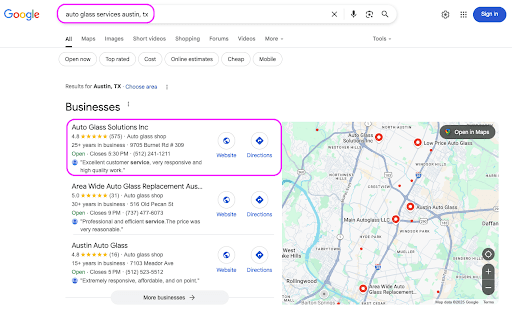
Lead Generation Price
Top Organic Leads started as an SEO company 22 years ago. Over the years, we've evolved into a lead generation company that focuses on SEO and website conversion rate optimization. We have a combination of multiple services and offer a pay-per-lead model, rather than the traditional monthly fee charged by most SEO companies. This pay-per-lead process isn’t like the one provided by lead generation companies that charge you for crappy leads that are also sent to your competitors; we only charge per qualified, exclusive leads that come in.
The price of a lead depends on the value of the customer that we’re able to generate. We have a formula generated by an AI technology. This formula allows us to assess the quality of a particular lead and assign a lifetime value to that customer.
AI has given us the ability to estimate the value of each lead as a customer. We calculate a lifetime profit for that customer and base our pricing on that, which is 5% of the customer value. In most markets, the closing rate of the business is 50% from inbound leads, so we divide that by 5% of customer value. Now our pricing is obvious, 2.5% of customer value. (Of course, the numbers are subject to change, and the final result might be different in different businesses.)
Why Top Organic Leads?
Top Organic Leads is basically an SEO company that charges as a lead generation service. It means we don’t sell you crappy leads, we don’t sell you leads that are also available for your competitors, and we don’t sell you leads that will sue you for being a scam.
What we do is beyond that: We work on your website, content, GBP (Google Business Profile), and everything on your online storefront.
And BOOM, New leads will flood in. We won’t charge you for the services we provide; we charge you for the leads generated, only approved ones.
Final Thoughts
Everyone starting a business needs to understand that the engine of every business is sales, and sales requires people who find out about and develop an interest in your product/service. Think of your website as your storefront. If you want everyone to shop from you, you must get a store downtown, not outside the city. You also need to have a clean, beautiful store to attract customers. Accordingly, you need a gorgeous website that is ranked high in Google search.
When people visit your website, we refer to them as traffic. When they call you or fill out a form, we refer to them as leads. At this point, the sales process starts. Once these leads finally make a purchase or sign the contract, they are our real customers. To achieve this goal, marketing is essential. This is where our job at Top Organic Leads comes in. We bring the customer from the street into your store.

